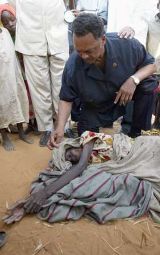Scientific survey confirms humanitarian disaster in Sudan’s Darfur
By EMMA ROSS, Associated Press Writer
LONDON, Oct 1, 2004 (AP) — The first scientific survey to assess the deadly nature of the conflict in the Sudan’s Darfur region has found that death rates there were three to 10 times higher than normally found in sub-Saharan, highlighting the gravity of the crisis.
 Experts say the survey — a rare study of people fleeing violence — could be used to hold those behind the killings accountable for their actions.
Experts say the survey — a rare study of people fleeing violence — could be used to hold those behind the killings accountable for their actions.
Between April and June of this year, Dr. Evelyn Depoortee of the Epicenter in Paris, together with researchers from the French arm of the relief organization Doctors Without Borders, surveyed 215,400 people taking refuge in four locations in West Darfur to compare death rates in the region before and after the people were driven from their homes.
Their findings will be published Friday on the Web site of The Lancet medical journal.
“Humanitarian aid workers have long suspected, and occasionally shown, that the events precipitating displacement and the period of relocation itself are especially dangerous, but clear epidemiological evidence of this increased risk is rare,” according to an independent critique of the survey by Bradley Woodruff and Reinhard Kaiser of the U.S. Centers for Disease Control and Prevention.
The bloodletting in Darfur began in February 2003, when two non-Arab African rebel groups launched attacks primarily on government and military targets to press demand for a greater share of power and resources for the region.
The government is accused of trying to put down the rebellion by backing armed Arab herdsmen known as Janjaweed who long have competed with villagers over Darfur’s scarce resources. The escalating violence has been described by the United States as genocide. The United Nations has said Darfur is the world’s worst humanitarian crisis.
Over 50,000 have died, and at least 1.2 million others displaced by fighting.
The survey, the most scientifically accurate study of the death toll from the conflict, included 43 percent of the estimated 500,000 displaced within West Darfur, one of the three provinces that make up the Darfur region.
It found that during the attacks and subsequent flights across the arid terrain to refugee camos, death rates were between 6 and 95 deaths per day per 10,000 people — well above the benchmark of 1 that the United Nations considers an emergency situation.
Violence accounted for between 68 percent and 93 percent of those deaths, the researchers report.
The normal death rate for Sub-Saharan Africa is 0.5 per 10,000 people per day, experts say.
“The proportion of people younger than 5 years were as expected for sub-Saharan Africa, but the overall male-to-female ratio showed a deficit in male people,” the report said, indicating that government-backed militias are largely targeting men.
Most of the people said they fled their homes because of attacks on their villages.
In the camps, death rates decreased but remained above the emergency benchmark, with the highest rates of 5.6 deaths per day per 10,000 people seen in the region around El Geneina, the survey found.
Sickness was the predominant cause of death in the camps, but violence persisted and led to more than 20 percent of deaths in one camp studied. All the killings were ascribed to militia surrounding the camps, the investigators said.
Evidence on the extent of violence in Darfur has largely relied on testimonies from refugees in Chad — where more than 200,000 have fled — or preliminary assessments done when researchers could get to certain sites in Darfur.
Estimates of the number of people killed increased progressively from 3,000 in January this year, to 10,000 by April and 50,000 by July.
“Our findings do not in themselves substantiate claims that events in Darfur amount to genocide, not least because this would require demonstration of such an intent on the part of the perpetrators,” the investigators wrote. “Nevertheless, we believe that, in the four sites we surveyed, high mortality and family separations amount to a demographic catastrophe.”
